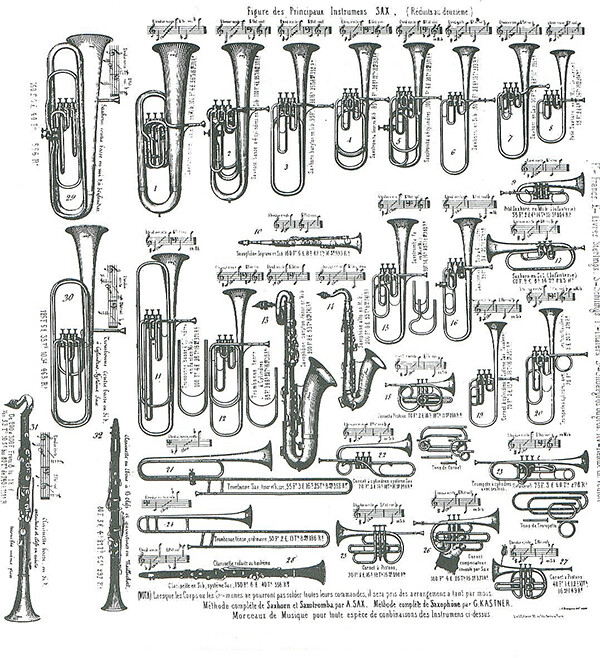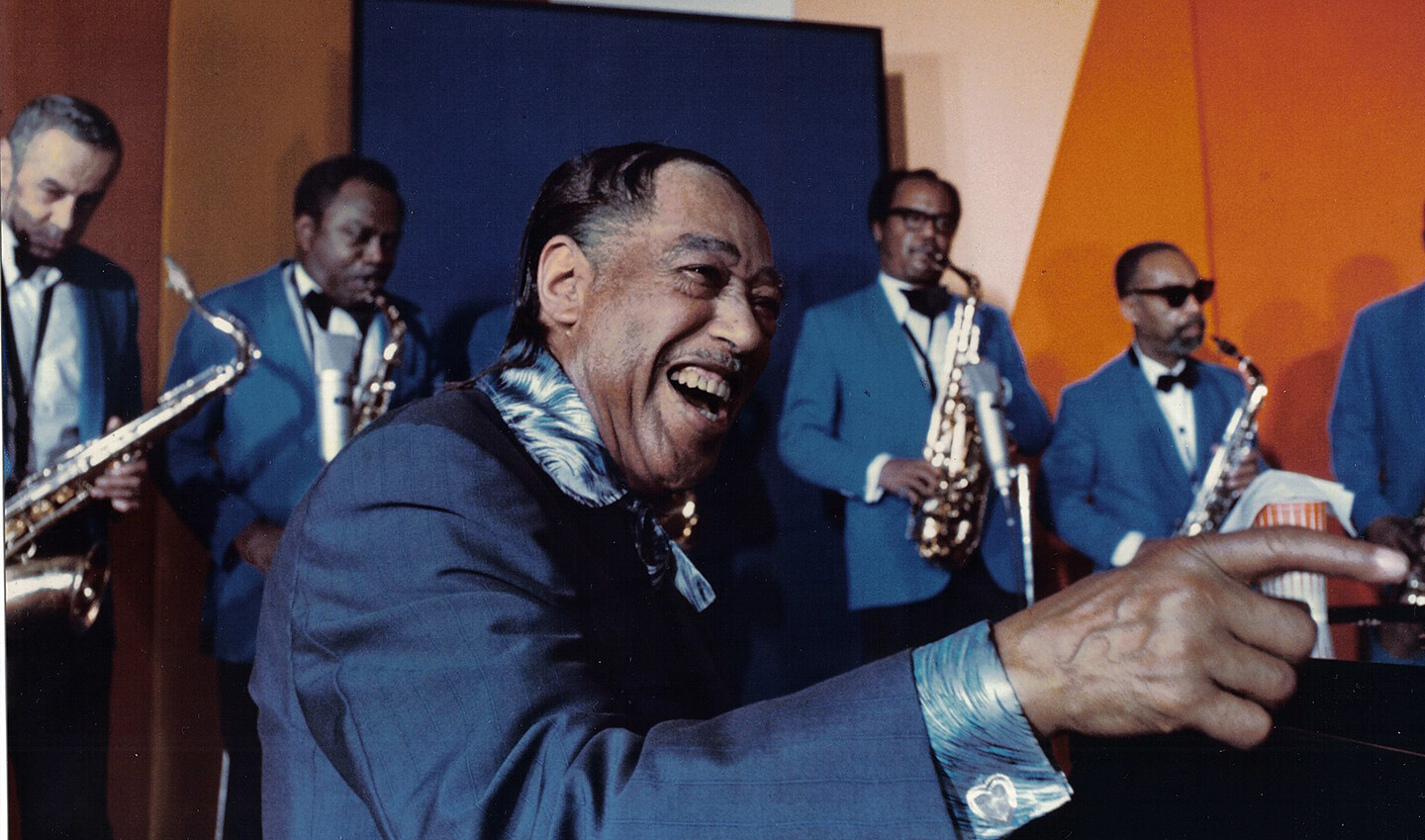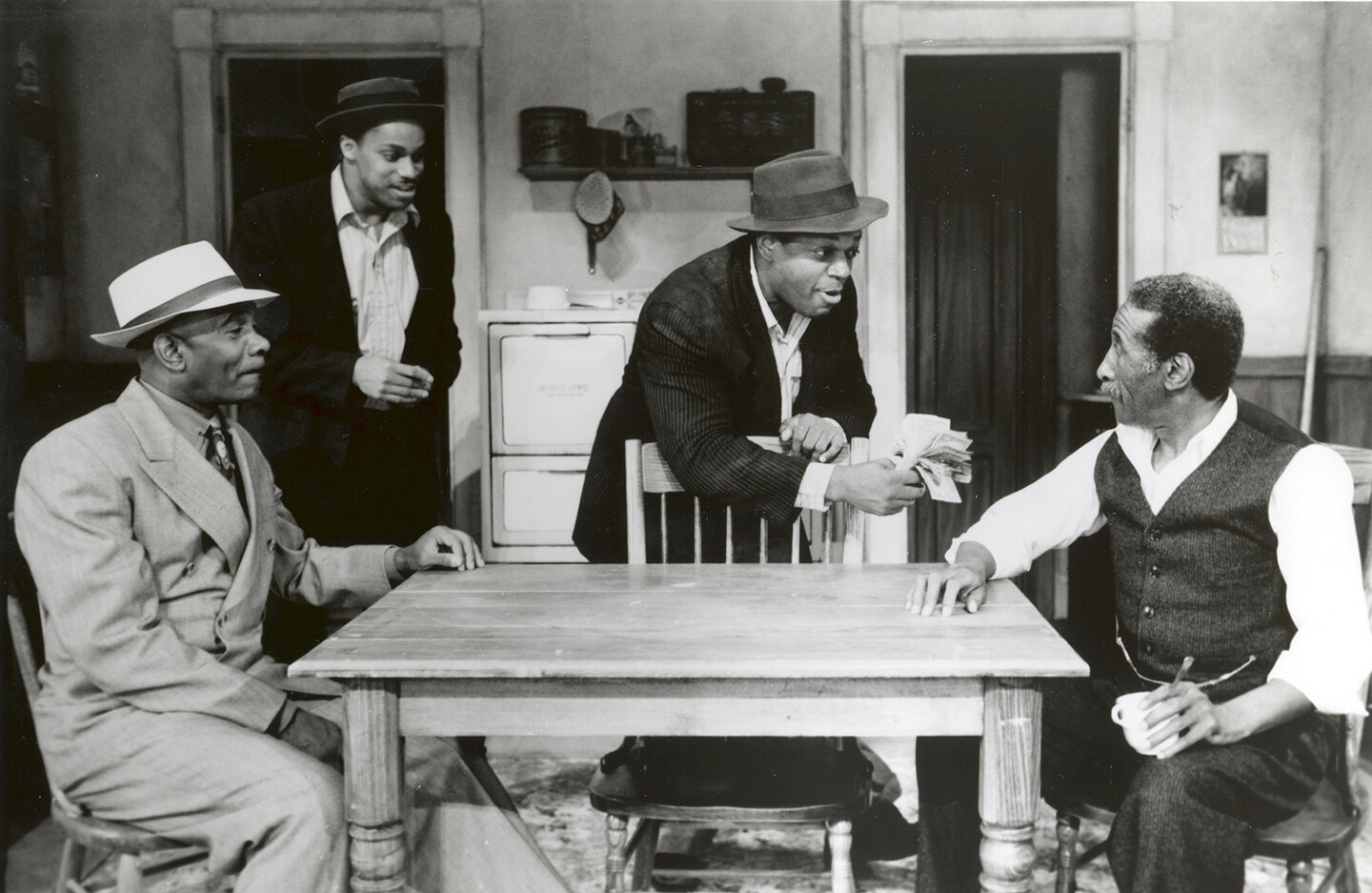Our story begins in the small city of Dinant in southern Belgium, where in 1814 a boy named Adolphe Sax was born. It didn’t take long for his life to take a tragic turn, for it began to seem as if the surrounding world wanted to kill him. As a toddler, he fell three stories from a window and somehow managed to survive. At three, he accidentally drank poisoned water and survived. Later he ate a pin. He banged his head. Fell again. Consumed poison again. Was scorched by a gunpowder explosion. The city of Dinant informs tourists that “Little Sax” was known as “the ghost.”1
What to make of this? A nineteenth-century Belgian boy appears to have a lot of bad luck. We could leave it at that. But there’s more. Adolphe Sax is also known for something else: inventing the saxophone. First appearing in the 1840s, the saxophone drew some interest from composers but never managed to enter European orchestral music in any major way before falling out of fashion by the end of the century. Sax’s invention was not for its own time, but for the future—the next century, in another country and culture.


A catalogue showing various Adolphe Sax instruments, including saxhorns, saxophones, and saxotrombas. License: Public Domain.
Let’s imagine, in the manner of Huge Everett’s multiverse hypothesis,2 that the young Sax is killed by one of his many close calls (pin, poison, fall) and the saxophone is not invented. In this world, the center of Black American culture suddenly vanishes, turning Duke Ellington’s band to ashes like the superheroes at the end of Avengers: Infinity War. Nothing becomes of John Coltrane. Andrew “Mike” Terry’s saxophone solo on the Supremes’ “Where Did Our Love Go” echoes into a ghostly silence. Just as it’s nearly impossible to imagine the twentieth century without Black American music, it’s almost impossible to imagine Black American music without the saxophone—a European instrument treated as mere novelty until it reached a culture its creator had no direct contact with. Even more curious, young Adolphe Sax almost drowned in a river—an important detail if one recalls Octavia Butler’s time-traveling novel Kindred.
Though primarily known as a science fiction writer—her books are full of aliens, spaceships, dystopian futures, and explorations of the possible direction of new technology—I see Octavia Butler primarily as a philosopher. Just as Donna Haraway’s famous 1985 “A Cyborg Manifesto,” blurs the line between what we perceive as us and not us, human and not human, in Butler’s Clay’s Ark, also published in the mid-eighties (as the penultimate novel in the Patternist series that launched Butler’s career in 1976), humans are infected by an alien microorganism that exhibits, like all life on earth, what Spinoza described as conatus, the inner drive to stay alive and flourish.
Haraway, however, is plainly a philosopher in the Foucauldian school of social theory; Butler, whose fiction also takes this philosophical form, is not. All of her novels are recognized as science fiction, which is why many can’t stop pointing out that she was the first science fiction writer to receive a MacArthur grant. But philosophers don’t just write philosophical treatises: they write dialogues, aphorisms, novels, manifestos, and even science fiction. The question then is: What comes first, the mode or the function? For Deleuze and Guattari’s last collaboration, What Is Philosophy?, the answer is found in “the art of forming, inventing, and fabricating concepts.” True, the “sciences, arts, and philosophies are all equally creative,” but “only philosophy creates concepts in the strict sense.”3 To see Butler primarily as a philosopher, as a brilliant creator of concepts, is to appreciate her genius and contributions more deeply.


Duke Ellington with his band in 1971. License CC BY-SA 3.0.
Butler’s most famous novel, Kindred, cannot even be described as science fiction.4 It has no aliens, no spaceships, and doesn’t project the leading technology or culture of its time into the future. Instead, it goes into the past, with no explanation for how such time traveling works. It just happens. The novel’s central character, Dana Franklin, a Black woman married to a white man, Kevin Franklin, departs from her present time (the mid-seventies) and place (Los Angeles) into a distant time (the early nineteenth century) and place (Maryland). The space-time transportation involves her periodically losing consciousness, then regaining it on a plantation owned by one of her ancestors, Tom Weylin. Without any explanation, the space-time travel appears to be triggered by the slave-owner’s son, Rufus, a white boy who will later become, by the crime of rape, Dana’s blood relative. Regardless, Dana always arrives in the past at the exact moment Rufus is in danger, about to be killed by a fire or a fall from a tree. The first time Dana rescues Rufus, he’s about to drown in a river. By saving him, she saves her future self.
It is fair to argue that the concept for Kindred could only have been conceived in a culture that has, to some measure, absorbed and extended the conclusions of what is now known, for better or worse, as the Copenhagen interpretation of the behavior of fundamental stuff.5 Dana jumps from the present to the past in a manner that recalls quantum tunneling, and her connection to Rufus recalls quantum entanglement. You will not find a match for this kind of space-time tunneling and entanglement in classical mechanics. Kindred was, after all, completed around the time that the last great discoveries were made in physics.6 And Butler read widely: science, science fiction, literature, slave narratives. Her mind was a university.
Now let’s go to the sun. How does the light of our nearest star come about? Proton-proton fusion. But there is a problem with this fusion, which transforms hydrogen into helium: a lot of energy is needed to make the protons, which have the same positive charge, and to overcome what is called Coulomb repulsion, which repels particles with the same charge. Let’s skip the details and get right to it: for two protons to couple, they must be close enough for one of the four known forces, the strong force, to kick in and join them together. Keep in mind that the closer the protons, the stronger the repulsion. This is why such a huge amount of energy is needed for the strong force to overcome this barrier. Yet our sun, like many other stars, doesn’t produce the energy required to conduct a conventional energy-releasing union—meaning that there really shouldn’t be any light coming from the sun at all. In a Newtonian universe determined by classical mechanics (standard cause and effect), the sun should not even be radiating the energy that makes life, us, and all that is like us—Haraway’s “queer messmates” and beyond—possible in the first place. How then does the sun burn if, like other stars, it lacks the energy needed to overwhelm Coulomb repulsion? The answer is found in the magic of quantum tunneling.
That great ball in the sky is driven by quantum mechanics. What happens is: there’s so much hydrogen sloshing around in its core that the probability of a proton being here and then suddenly there, beyond the Coulomb barrier, is not only possible but happens often. This is quantum tunneling. In most cases the mechanics of particles collapse into classical mechanics; but sometimes (and rarely) it does not. From the very small comes the very large: flowers, birds, apes, whales, and so forth. We are directly entangled with what can only be described as quantum magic. The juncture between quantum events and an observer’s information, knowledge, or conscious awareness, known as the Heisenberg cut, is indeterminable. And this indeterminacy can only lead us to John Wheeler’s participatory universe, which follows from his famous (and proven) “delayed choice” thought experiment.7 When we look at the stars, we don’t just look into the past, but we participate, to a significant degree, in the way it looks. The observer and the observed cannot be separated. This is not just mystical nonsense. As with our memory, looking at the universe, which is also looking back in time, is a creative process.
I want to offer another, and possibly deeper, interpretation of Kindred’s key concept: time travel means haunting the past.8 Dana, as well as her husband (who travels back with her when Rufus falls from a tree), are really ghosts visiting what Burning Spear called “the days of slavery.” The slave owner’s wife, Margret Weylin, and her son, Rufus, see Dana and Kevin as ghosts. And it is here we must pause to note that this kind of haunting is very unusual. Ghosts usually come from the past, not the future. I can’t recall any haunting from the future in the Western tradition, nor in the ancient Japanese ghost stories collected by Lafcadio Hearn (1850–1904).9 If we look at one of the most famous Black American ghost stories, August Wilson’s play The Piano Lesson, we find what is also in Robert Zemeckis’s film What Lies Beneath (though with a twist concerning property rights). Both are about an unsolved past crime haunting the present. The future must pay for this crime.10


Lou Myers, Rocky Carroll, Samuel K. Jackson, and Carol Gordon in The Piano Lesson at Yale Repertory Theatre. Photo by Gerry Goodstein, 1987.
As the most dominant kind of haunting we have in our culture, what is the social function of this justice-determined ghost?11 By “social function” I mean to say, What is the sociobiology of justice-determined haunting in this temporal form: from past to the present? For the answer we can look to the father of the capitalist science of economics (formerly, and correctly, known as political economy) Adam Smith, writing on ghosts in 1759:
When we see one man oppressed or injured by another, the sympathy which we feel with the distress of the sufferer seems to serve only to animate our fellow-feeling with his resentment against the offender. We are rejoiced to see him attack his adversary in his turn, and are eager and ready to assist him whenever he exerts himself for defence, or even for vengeance within a certain degree. If the injured should perish in the quarrel, we not only sympathize with the real resentment of his friends and relations, but with the imaginary resentment which in fancy we lend to the dead, who is no longer capable of feeling that or any other human sentiment. But as we put ourselves in his situation, as we enter, as it were, into his body, and in our imaginations, in some measure, animate anew the deformed and mangled carcass of the slain, when we bring home in this manner his case to our own bosoms, we feel upon this, as upon many other occasions, an emotion which the person principally concerned is incapable of feeling, and which yet we feel by an illusive sympathy with him.12
For Adam Smith, the dead are really dead—done with the world of the living. They cannot haunt. It is only our own moral imagination—made powerful by our ultra-sociality (as the cetologist Hal Whitehead calls it)—that makes the nonliving and wronged appear in the present to demand justice. More from Smith:
The sympathetic tears which we shed for that immense and irretrievable loss, which in our fancy he appears to have sustained, seem to be but a small part of the duty which we owe him. The injury which he has suffered demands, we think, a principal part of our attention. We feel that resentment which we imagine he ought to feel, and which he would feel, if in his cold and lifeless body there remained any consciousness of what passes upon earth. His blood, we think, calls aloud for vengeance. The very ashes of the dead seem to be disturbed at the thought that his injuries are to pass unrevenged. The horrors which are supposed to haunt the bed of the murderer, the ghosts which, superstition imagines, rise from their graves to demand vengeance upon those who brought them to an untimely end, all take their origin from this natural sympathy with the imaginary resentment of the slain. And with regard, at least, to this most dreadful of all crimes, Nature, antecedent to all reflections upon the utility of punishment, has in this manner stamped upon the human heart, in the strongest and most indelible characters, an immediate and instinctive approbation of the sacred and necessary law of retaliation.13
This is a vivid and accurate sociobiological account of the traditional ghost in the West (and Japan14). The violent crime or wrongdoing is not about the dead, but about the living. This is a profound insight. The ghost of the woman murdered by Harrison Ford’s character in What Lies Beneath is not and could never be present. Her house-haunting is all about the people who survived her. Ghosts powerfully feel a necessity to settle otherworldly scores because they are ultra-social animals.15 We demand justice not only for the living, but also for the dead. These are our ghosts in truth.16
The dead who suffered injustice are really dead. This is the point Max Horkheimer made to Walter Benjamin in a March 16, 1937 letter that appears in Benjamin’s Arcades Project:
The determination of incompleteness is idealistic if completeness is not comprised within it. Past injustice has occurred and is completed. The slain are really slain … If one takes total lack of closure entirely seriously, one must believe in the Last Judgment … Perhaps, with regard to incompleteness, there is a difference between the positive and the negative, so that only the injustice, the horror, the sufferings of the past are irreparable. The justice practiced, the joys, the works, have a different relation to time, for their positive character is largely negated by the transience of things. This holds first and foremost for individual existence, in which it is not the happiness but the unhappiness that is sealed by death.17
Benjamin’s response:
The corrective to this line of thinking may be found in the consideration that history is not simply a science but also and not least a form of remembrance. What science has “determined” remembrance can modify. Such mindfulness can make the incomplete (happiness) into something complete, and the complete (suffering) into something incomplete. That is theology; but in remembrance we have an experience that forbids us to conceive of history as fundamentally atheological, little as it may be granted us to try to write it with immediately theological concepts.18
Here we have Benjamin, soon to kill himself because the Nazis want to kill him, facing the horror: the slain are really slain. There is no future for them. These thoughts are crowding his mind as he writes the last of his “Theses on the Philosophy History” in 1940. As a Jew, he knows the Nazi catastrophe is right around the corner. As a Marxist, he looks back at the horrors of capitalism. The soul-destroying work, the attacks on strikers, the long working day, the imperial wars. None of this will be redeemed? He decides to reject Horkheimer and resuscitate the dead by bizarrely blending theology with historical materialism. The dead must rise and we must hear their call from where we are now, lest we repeat those past atrocities.


Resurrection Mary, taken at the Electric Theater night club at 4812 North Clark Street, Chicago, April 5, 1968. Source: Chicago Sun-Times Collection.
I part with Benjamin on this point and go with Horkheimer and Smith: the dead are nothing, are not with us, are gone forever.19 But Kindred’s rethinking of haunting offers us a way to awaken the dead, not in our own time but, of all places, in their time. This is the philosophy of time at the core of Kindred. And this is where Octavia Butler makes a connection with the participatory universe. We can only look back in time—only we, the living, can haunt. And what we haunt is the past. When Rufus calls Dana a ghost, she replies that she isn’t there to calm him (she’s trying to save him, after all). But that’s how his mother, Margret Weylin, explains Dana’s visits and vanishings—she must be a ghost. And Margret is right (though she doesn’t know it): only the living can visit the dead, not the other way around. We’re there when George Washington buys a slave. We’re there when a tree bears strange fruit.20 We’re there in the gas chambers, or when Winston Churchill starves to death millions of Indians. And as we in the present are in the past, we are also haunted by those in the future, those not yet born.
In fact, our friends from the future are already among us. But what of Adolphe Sax, inventor of the saxophone? His encounter with black ghosts from the future appears to end not as catastrophically as Rufus Weylin’s.21 The Belgian village of Dinant writes that his near-death incidents were only the prelude to an eventful life: “In 1858, Adolphe Sax was miraculously saved from a cancer of the lip by a black doctor who knew the properties of certain Indian plants. What would the future have been but for this intervention?”22
See →.
The physicist Huge Everett, a student of John Wheeler, published in 1957 a paper that proposed the “Many-Worlds” hypothesis as a solution to the indeterminacy described by the Copenhagen interpretation of quantum mechanics. What this means is that Leibnizian compossibles (or Staurt Kauffmann’s adjacent possibles) are not concentrated in (or left with) one (best of all) world but are constantly splitting into other worlds. A possibility that does not make it into this world does not vanish but enters another one. This way of thinking also explains Delueze’s claim that the virtual is as real as the actual.
Gilles Deleuze and Félix Guattari, What Is Philosophy?, trans. Graham Burchell and Hugh Tomlinson (Columbia University Press, 1996), 2, 5.
FX’s 2022 television adaptation of Kindred turned out to be barely mediocre, which is surprising when one considers the narrative power of Butler’s novel, which begins with a cinematically vivid image and situation. From that point on, the pages just fly. Though the writer and showrunner of the series, Branden Jacobs-Jenkins, preserved the main features of the novel’s time traveling, he made significant changes to large sections of the original story, which made fans of the novel deeply unhappy.
Agnieszka Polska and Geo Wyeth’s installation The Happiest Thought inspired the course of thinking in the first half of this essay.
This moment in physics was called the November Revolution. Fred Gilman writes: “As the name ‘revolution’ implies, the discoveries of November 1974 were not just additions to our knowledge of Nature. Instead they signaled a change in our understanding of the structure of matter: that the particles in the nucleus of the atom are themselves composite and are made of quarks. This new layer of structure, the quark level, was moreover one for which we have simple equations to describe the forces which act on the quarks. Thus there emerged what is called the Standard Model of the structure of matter and its forces.” After this revolution, physics fell into silence until the discovery of the Higgs boson particle, first proposed in 1964, was confirmed by the Large Hadron Collider in 2012. Fred Gilman, “The November Revolution,” SLAC Beam Line 16, no. 1 (1985): 3.
James Wheeler, “The ‘Past’ and the ‘Delayed-Choice’ Double-Slit Experiment,” in Mathematical Foundations of Quantum Theory, ed. A. R. Marlow (Academic Press, 1978).
The core ideas in the remaining sections of this work were first presented in a lecture I delivered at the Swiss Institute in 2020 →.
See Lafcadio Hearn’s In Ghostly Japan (1899) and Kwaidan: Stories and Studies of Strange Things (1904). In 1964, Masaki Kobayashi made Kwaidan into one of the masterpieces of twentieth-century Japanese cinema. The past, again, haunts the present in Kaneto Shindo’s 1968 Kuroneko (Black Cat), which is the greatest film about ghosts in the history of cinema. A mother and daughter are raped and killed by a troop of samurai. The horror of this crime is so extreme that it enables the mother and daughter to break the order of time—the fixed past, the dynamic present, the open future. Their ghosts can now visit the present for the purpose of exacting revenge against any samurai who enters the bamboo grove. The mother and daughter lure them to their home, then turn into demonic cats that eat the doomed samurai. In this common reading of ghosts, an event of extreme evil (or injustice) has the emotional force to propel the present into the past.
In the Japanese ghost stories collected by Lafcadio Hearn, ghosts often have no vendetta. They just want to be loved and spend time with those in the present.
I must point out that ghosts in Southern Africa are very difficult to figure out. They certainly come from the past, but their motives are not always clear. And you get into trouble with them precisely because you have failed to read their often-complicated motives. Southern African ghosts also hate those who do not believe in them. This arrogance is, of course, a great injustice. For more on this, read Charles Mungoshi’s collection of short stories Coming of the Dry Season (1972).
Adam Smith, The Theory of Moral Sentiments (1759), ed. Knud Haakonssen (Cambridge University Press, 2004), 82–83.
Smith, The Theory of Moral Sentiments, 83.
Some ghosts in the Japanese tradition are not all vengeful. They simply miss the company of the living, and go to great lengths to fool the living into thinking they are not dead. One can see this kind of ghost in Kenji Mizoguchi’s masterpiece Ugetsu.
The ghost as a figure certainly needs the emergence of hyper-culturality from ultra-sociality. Ants are also ultra-social, but not hyper-cultural. There are no ghost ants.
A whole scientific field is devoted to mirror neurons of the mind. They enable us to imagine what’s in another person’s head. And though neuroscience was almost nonexistent in Adam Smith’s time, he got the psychology of the theory of mind correct. The dead person is not there. But the living feel for them. This connection, I think, is the ground of much revolutionary politics. We imagine the wrong done to, for example, Black African slaves in America, and we imagine how they would demand from the present that justice be done. This is how their ghosts haunt the present. It is by means of surplus human sociality—our profound fellow feeling.
Walter Benjamin, The Arcades Project, trans. Howard Eiland and Kevin McLaughlin (Harvard University Press, 1999), 471.
Benjamin, The Arcades Project, 471.
The Black slaves that saw nothing but a life of misery and pain on plantations (gone), the Indians starved to death by Winston Churchill (gone), the European Jews in the gas chambers (gone).
One of the ghost stories in Lafcadio Hearn’s Kwaidan, “The Story of Aoyagi,” is about a young man who encounters “a comely maiden” who turns out to be not only a ghost but the ghost of a tree. Southern African stories also do not limit ghosts to humans. Indeed, I recall that even a mushroom can haunt humans. However, I have yet to read or hear a ghost story that does not involve any humans whatsoever, e.g., a mushroom haunting future mushrooms or a tree haunting future trees.
In the end, Dana Franklin kills Rufus.
See →.
